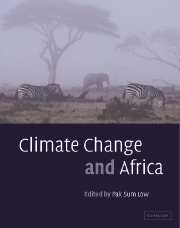Book contents
- Frontmatter
- Contents
- Notes on contributors
- Peer reviewers
- Editor's note
- Foreword
- Foreword
- Foreword
- Foreword
- Preface
- Preface
- Preface
- Preface
- List of abbreviations
- List of SI prefixes
- List of unit abbreviations
- List of chemical formulae
- Part I Science
- Part II Sustainable energy development, mitigation and policy
- Part III Vulnerability and adaptation
- Part IV Capacity-building
- 26 Climate change mitigation analysis in southern African countries: capacity enhancement in Botswana, Tanzania and Zambia
- 27 Capacity-building initiatives to implement the climate change convention in Africa
- 28 Education and public awareness: foundations of energy efficiency
- Part V Lessons from the Montreal Protocol
- Index
28 - Education and public awareness: foundations of energy efficiency
Published online by Cambridge University Press: 10 December 2009
- Frontmatter
- Contents
- Notes on contributors
- Peer reviewers
- Editor's note
- Foreword
- Foreword
- Foreword
- Foreword
- Preface
- Preface
- Preface
- Preface
- List of abbreviations
- List of SI prefixes
- List of unit abbreviations
- List of chemical formulae
- Part I Science
- Part II Sustainable energy development, mitigation and policy
- Part III Vulnerability and adaptation
- Part IV Capacity-building
- 26 Climate change mitigation analysis in southern African countries: capacity enhancement in Botswana, Tanzania and Zambia
- 27 Capacity-building initiatives to implement the climate change convention in Africa
- 28 Education and public awareness: foundations of energy efficiency
- Part V Lessons from the Montreal Protocol
- Index
Summary
Keywords
Climate change mitigation; greenhouse gas abatement; education; community; teachers; teacher-education; Africa
Abstarct
Increased population and modest economic growth are likely to result in a 10-fold increase in emissions of greenhouse gases for the African continent over the next two to three decades. If economic growth can be achieved with lower than expected fossil fuel use increases, then substantial global benefits would result. An important long-term opportunity for ‘no regrets’ action on climate change is education in both the formal (school) and informal (community) sectors. To be effective, the education programme must inform, enthuse and empower. This requires demonstration of the relevance of climate change mitigation and adaptation strategies to the individual. Within the school sector, it is conceivable that a well-planned education programme aimed at improving awareness of energy minimization actions and the importance of global climate could reach 100 million school children within three to four years. Community education must be flexible and support, but not attempt to manage, existing community organizations.
INTRODUCTION
The continent of Africa, with its 50 countries and vast differences in economic, cultural, and political systems, presents enormous challenges for those charged with the implementation of sustainable development and the design of responses to the threat of climate change. The magnitude of the problem, together with this diversity, immediately raises the question – is there anything that can be said that might be common to all these countries? In detail, probably not, but there are broad principles that can be applied.
- Type
- Chapter
- Information
- Climate Change and Africa , pp. 310 - 316Publisher: Cambridge University PressPrint publication year: 2005



